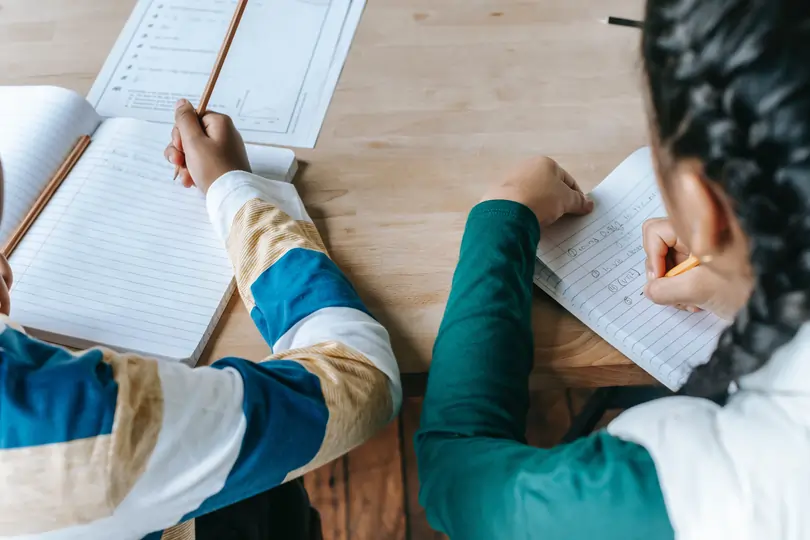Multiplication And Division 2
In this article, we will be learning about Multiplication and Division and the learning objectives are:
- Understanding division as equal sharing
- Understanding division as equal grouping
- Relating multiplication and division
Topic Recap:
Understanding division as equal sharing
- We divide when we share equally.
- Sharing equally means each group gets the same number of objects.
- To find the number of objects in each group, we need:
- The total number of objects
- The total number of groups
Start by distributing 1 object to each group.
Example:
Share \(\small{6}\) balloons equally between two children.
How many balloons does each child get?
Solution:
Let’s begin by giving \(\small{1}\) balloon to each child. Repeat until all the balloons have been equally distributed.
Each child gets \(3\) balloons.
Answer:
\(3\) balloons
Question 1:
Share \(10\) lollipops equally between two children. How many lollipops does each child get?
- \(5\)
- \(6\)
- \(3\)
- \(4\)
Solution:
Start by distributing \(1\) lollipop to each child. Repeat until all the lollipops have been equally distributed.
Answer:
(1) \(5\)
Question 2:
Put \(9\) bunches of grapes equally into \(3\) baskets. How many bunches of grapes are there in each basket?
\(3\) groups of _________ \(= 9\)
- \(6\)
- \(2\)
- \(3\)
- \(4\)
Solution:
Begin by putting \(1\) bunch of grapes in each basket. Repeat until all the bunches of grapes have been equally distributed.
\(3\) groups of \(3 = 9\)
Answer:
(3) \(3\)
1. Maths concept: Understanding division as equal sharing
Example:
Divide \(14\) balloons into \(2\) equal groups.
Sharing equally means that each group will get the same number of items.
When you share \(14\) balloons equally into two groups, there will be \(7\) balloons in each group.
This can be represented as:
\(14 \div 2 = 7\)
‘\(\div\)’ means divided by.
We read the division equation above as ‘fourteen divided by two equals seven’. We can also say ‘Divide \(14\) by \(2\)’.
This can also be represented as:
\(2\) groups of \(7 = 14\)
\(2 \times 7 = 14\)
Question 1:
Look at the following.
Divide \(16\) candies into \(4\) equal groups.
- Choose the correct option to represent the sentence above.
- \(4 \div 16\)
- \(16 \div 4\)
Answer:
(2) \(16 \div 4\)
- How many candies are there in each group above?
- \(8\)
- \(12\)
- \(3\)
- \(4\)
Solution:
\(16 \div 4 = 4\)
Answer:
(4) \(4\)
Question 2:
Divide \(15\) crayons into \(3\) equal groups. How many crayons are there in each group?
- \(5\)
- \(6\)
- \(3\)
- \(12\)
Solution:
\(15 \div 3 = 5\)
Answer:
(1) \(5\)
Question 3:
\(5\) boys went fishing. They caught 10 fish altogether. Each boy caught the same number of fish. How many fish did each boy catch?
- \(5\)
- \(2\)
- \(10\)
- \(50\)
Solution:
\(10 \div 5 = 2\)
Answer:
(2) \(2\)
Topic Recap:
Understanding division as equal grouping
- We divide by equal grouping when we put objects into groups of the same number.
- Equal grouping means to divide a number of objects into groups of the same number.
- To find the number of groups, we need:
- The total number of objects, and
- The total number of objects to be put in each group
Example 1:
Divide the elephants into equal groups.
There are \(12\) elephants.
Start by identifying how many elephants are to be put in each group.
If we divide the elephants into groups of \(3\),
There will be \(4\) groups of \(3\).
This also means that \(4 \times 3 = 12\).
Similarly, if we divide these \(12\) elephants into groups of \(4\),
There will be \(3\) groups of \(4\) elephants each.
This also means that \(3 \times 4 = 12\).
Question 1:
Divide \(18\) strawberries into groups of \(3\). How many groups of strawberries are there?
__________ groups of \(3 = 18\)
- \(5\)
- \(6\)
- \(7\)
- \(8\)
Solution:
\(18 ÷ 3 = 6\)
\(6\) groups of \(3 = 18\)
Answer:
(2) \(2\)
Question 2:
Look at the picture below.
- How many groups of \(5\) are there?
- \(5\)
- \(10\)
- \(3\)
Solution:
Answer:
(3) \(3\)
- Max wants to pack \(5\) cookies in each bag. How many bags does he need to pack the cookies above?
- \(5\)
- \(10\)
- \(3\)
Solution:
\(15 \div 5 = 3\)
Answer:
(3) \(3\)
2. Understanding division as equal grouping
Divide \(20\) toy planes into groups of \(5\).
There are \(4\) groups of toy planes.
We write a division equation to find the number of groups:
\(20 \div 5 = 4\)
Total number of objects Number of objects in each group \(=\) Number of groups
We can also say that:
\(4\) groups of \(5 = 20\)
\(4 \times 5 = 20\)
Question 1:
Divide \(12\) apples in groups of \(2\).
- Choose the correct option that represents the statement above.
- \(12 \div 2\)
- \(2 \div 12\)
Answer:
(1) \(12 \div 2\)
- How many groups of apples are there?
- \(6\)
- \(2\)
- \(10\)
- \(4\)
Solution:
\(12 \div 2 = 6\)
Answer:
(1) \(6\)
Question 2:
Divide \(12\) children into groups of \(6\). How many groups of children are there?
- \(6\)
- \(2\)
- \(3\)
- \(12\)
Solution:
\(12 \div 6 = 2\)
Answer:
(2) \(2\)
Question 3:
Mr Ng prepared \(21\) sandwiches for a party. He puts \(7\) sandwiches on each tray. How many trays did he need?
- \(7\)
- \(2\)
- \(3\)
- \(4\)
Solution:
\(21 \div 7 = 3\)
Answer:
(3) \(3\)
Question 4:
Lindy uses \(3\) ice cream sticks to form a triangle. How many such triangles can she form using \(24\) sticks?
- \(7\)
- \(2\)
- \(3\)
- \(8\)
Solution:
\(24 \div 3 = 8\)
Answer:
(4) \(8\)
3. Relating multiplication and division
There are \(3\) pots.
There are \(5\) flowers in each pot.
There are \(15\) flowers in all.
From the given picture, we can write \(2\) multiplication and \(2\) division equations:
- \(5 \times 3 = 15\) and \(3 \times 5 = 15 \)
- \(15 \div 3 = 5\) and \(15 \div 5 = 3 \)
Question 1:
Ron collected \(10\) bottles for recycling.
- Which two multiplication equations best represent the picture above?
- \(2 \times 5 = 10\) and \(5 \times 2 = 10\)
- \(10 \times 2 = 5\) and \(10 \times 5 = 2\)
Answer:
(1) \(2 \times 5 = 10\) and \(5 × 2 = 10\)
- Which two division equations best represent the picture above?
- \(2 \div 5 = 10\) and \(5 \div 2 = 10\)
- \(10 \div 5 = 2\) and \(10 \div 2 = 5\)
Answer:
(2) \(10 \div 5 = 2\) and \(10 \div 2 = 5\)
Question 2:
What is the missing number?
- \(6\)
- \(2\)
- \(16\)
- \(4\)
Solution:
\(\begin{align} 2 \times 8 &= 16 \\[2ex] 8 \times 2 &= 16 \end{align} \)
The missing number is \(16\).
Answer:
(3) \(16\)
Question 3:
What are the values of \(X\) and \(Y\)?
- \( X = 8, Y = 5\)
- \(X = 8, Y = 40\)
- \(X = 5, Y = 40\)
Solution:
To find \( X\),
\(40 \div 5 = 8\)
To find \( Y\),
\(5 \times 8 = 40 \)
Answer:
(2) \(X = 8, Y = 40\)
In this article, we learnt division:
| Continue Learning | |
|---|---|
| Numbers To 1000 | Multiplication And Division 1 |
| Multiplication And Division 2 | Addition And Subtraction 1 |
| Addition And Subtraction 2 | Fractions 1 |
| Length 1 | Mass 1 |
| Volume 1 | Money 1 |
| Time 1 | Shapes And Patterns |
| Picture Graphs 1 | Model Drawing 1 |
| Model Drawing 4 | |


 SG
SG  VN
VN 

















